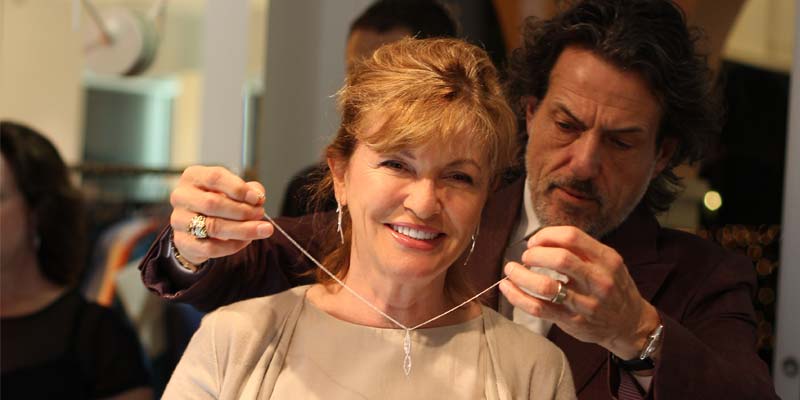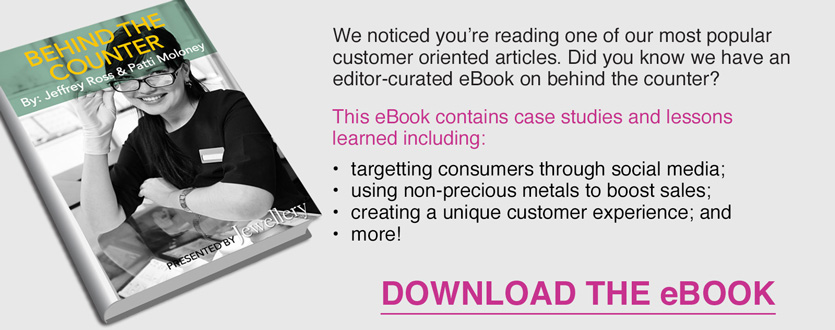Rocking a trunk show: Tips and tricks for a successful event
by jacquie_dealmeida | December 1, 2015 9:00 am
By Elizabeth Bonanno
 [1]
[1]Trunk shows are fun, unique ways to generate excitement around your store, and most importantly, drive traffic through your doors. Making these events successful, however, requires more than just putting extra jewellery in your cases. Proper planning and preparation is crucial to making the difference between your trunk show working for you, and simply giving yourself extra work. While the designer or brand representative is in your store to generate interest and excitement—in this case, Myriam Gumuchian (left)—it is still your job as the store owner or sales associate to close the sale.
I started my career working with high-end and incredibly rare estate jewellery. My mission in opening my own luxury brand development agency was to help contemporary jewellery designers understand their place in history, take curatorial responsibility for their collections, and to see their clients as collectors. My approach to my business is deliberate, strategic, and discerning and this is exactly how I produce and execute trunk shows on behalf of my clients. Here are some guidelines that have helped me rock successful trunk shows in the past.
Proper preparation

First thing’s first—what does your trunk show ‘look’ like? I always think it’s best to have a two- or three-day trunk show, with a celebratory party to kick things off or one held during the event itself. This not only gives your clients an opportunity to spend some social time with the brand representative or artist to form a more personal connection with him or her, but it also gives you more time to sell.
It’s a party, so plan accordingly. Are you serving champagne cocktails and hors d’oeuvres? Beer and pretzels? Cupcakes and coffee? Is this a daytime or evening event? Is it tied to a charitable organization that’s near and dear to your heart? The best way to determine how to proceed is to reflect on what’s worked (or not worked) in the past. What are your winning formulas? Is it easier for you to invite your clients as couples or to offer an event that caters to a ‘girls’ day’ or ‘ladies’ night?’ Do you get a lot of weekday traffic, or are your clients more inclined to come in over the weekend? Carefully thinking through how you want to form the event is your first step to success.
Whatever you decide, make sure all touch points of the plan and execution are in keeping with your brand and aligned as best as possible with the company’s or artist’s, as well. Also, make sure you give yourself enough time to properly plan and build buzz around the trunk show. While you can make things happen with a quicker turnaround time, I usually advise having something planned one to two months in advance.
So now what?

This is not a case of ‘build it and they will come.’ You’ve scheduled your designer’s visit and planned the special event, but now you have to get your clients in the door. This is really where the work begins. When it comes to the invitations, I always tell people to remove every obstacle. If your clients are responsive to e-mails, send an invitation electronically. If they never open their e-mail, send a printed invitation and always, no matter how you initially invite them, follow-up with individual phone calls to your key clients inviting them to stop in. And while you may not want to invite the general public to your special event, I strongly encourage you to use social media to promote the trunk show. Post an announcement about it, and in the days leading up to your event, do a countdown. This is also a good time to leverage the brand or designer’s social media by tagging them in your posts and providing them with your creative to push through their own social media channels.
Another key part of your preparation is communicating with the brand or designer. What are your expectations of them regarding the product, displays, boxes, catalogues, etc., you’d like them to bring? What about their attire, arrival and departure times, and are they providing you with access to high-resolution images? These are areas where, as they say, common sense isn’t always so common, so be sure to communicate your needs. If you host trunk shows frequently, you could create a form document to send out before every event. Remember to allow enough time for the brand representative or designer to meet your expectations.
It’s show time

While the designer or brand representative is in your store to generate interest and excitement, it is still your job as the store owner or sales associate to close the sale. Play off the designer, let him/her tell their story and the inspiration behind a collection or piece, and share your own passion for the brand with your clients. Make sure you’re creating a ‘yes’ environment when you interact with the customer. For instance, I never ask, “Would you like to see something?” Rather, I pose the question as, “We have so many beautiful things I’d love to show you, but they are only here for a limited time. Let me know what you’d like to see.” This ‘yes’ environment also extends to the hospitality you show the moment a client walks through the door. “Would you like something to drink?” is polite, but doesn’t create as much of an impact as it could. Instead, say to the client, “It’s so hot outside! I have iced tea or cold sparkling water. What can I bring you?”
As one would do in any sales environment, ‘read’ your client and his/her interests. Everyone has ‘tells’ and it’s important to know how to read them. Notice the items in which they show an interest. What do they have in common? What is the client responding to in particular? Are they more interested in the information behind the metal or gemstone in the piece, or are they excited by the inspiration behind the design? Whatever it is, I like to suggest you ‘speak to them where they live.’
It’s also a good idea to continually check your own energy. Are you too hyper? Too mellow? Too familiar? Too standoffish? It’s important to make your client comfortable, so they don’t leave the store without first having a meaningful interaction of some sort.
Throughout the trunk show, make sure you’re taking careful notes on the piece(s) your clients show an interest in and follow-up with images and information via e-mail or text depending on their preference. You should also take advantage of the event by photographing it for use on social media. Get your clients to play dress up with the jewellery and ask their permission to post their photo on social media. You don’t have to include their name or even their face, but seeing jewellery in action is a great way to get your followers to visit your store. The images you don’t post in real time can be used at a later date. And speaking of later dates”¦
It’s not over until it’s over

You can continue to build excitement for a brand or designer long after they’ve left the store. Posting images on social media allows clients to relive all the excitement of the trunk show and it’s a way of getting people to look forward to your next event. You can also follow-up directly with key clients who were unable to stop in by sending images of pieces you feel confident they’ll like and use the opportunity to build excitement for your next event. Keep in mind it’s a challenging environment out there in the consumer world; bombarding clients with too many events may actually work against you. Make sure what you are presenting to your clientele is thoughtful, interesting, and an experience not easily forgotten.
Elizabeth Bonanno is owner ofThe EAB Project, a luxury brand development agency dedicated to the artistic integrity of the designers on its roster, mapping out the trajectory of their careers, and working to create a strategic and mindful plan of action for their retail partnerships. She can be reached at elizabeth@theeabproject.com.[2] Â
- [Image]: http://www.jewellerybusiness.com/wp-content/uploads/2015/11/trunk-show-main.jpg
- elizabeth@theeabproject.com.: mailto:elizabeth@theeabproject.com
Source URL: https://www.jewellerybusiness.com/features/rocking-a-trunk-show/

